Looking for a detailed breakdown of all of the leg machines at your local gym? Look no further. Here’s a full look at all of the leg workout machines including muscles worked, benefits, and more.
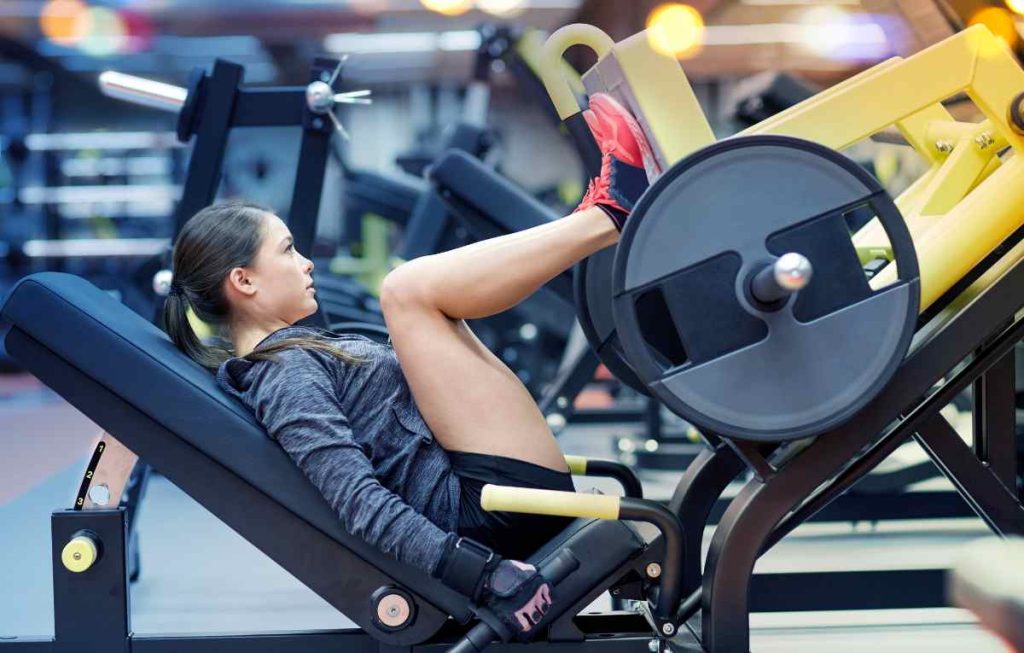
Stepping into the gym, you’ll quickly notice that there is no shortage of machines for building leg muscle and strength.
From free weights to machines, there are lots to choose from!
So much so, that you can quickly get overwhelmed when it comes to Leg Day at the gym.
Fret not, mon frere.
The best machines for legs at the gym are:
- Leg press machine
- Hack squat machine
- Leg extension machine
- Leg curl machine
- Hip abduction/adduction machine
- Calf raise machine
- Smith Machine
In this detailed guide to the top leg machines at the gym, we will look at the most effective machines for developing lower body strength and muscle.
We’ll look at the benefits of each, the muscles worked, and what you need to know about taking leg day to the next level.
Let’s get after it.
Why use leg machines at the gym?
Training your legs regularly and frequently at the gym not only helps build lean muscle tissue, but also helps keep your metabolism roaring (speeding up fat burn), supports functional movements like walking and sitting, and can also help combat and manage chronic health conditions.
While more experienced lifters will use free weights (barbells, squat racks, dumbbells, etc), for the beginner lifter, or the lifter who wants to accessorize their workout regimen with something new, there are some excellent leg machines at your disposal.
The key benefits to training on a machine include:
✅ Excellent for isolation – Strength training machines remove the stability requirements that are inherent in free weight training. You don’t have to worry about balancing yourself. That means all of your efforts is being expended by the major muscle groups.
✅ Great for developing confidence in the gym – People new to the gym are frequently intimidated by the clang-and-bang of racks and iron. Machines are a great introduction to strength training and building confidence before moving on to free weights as they provide a controlled environment for lifting, with safety hooks, latches, and locks that prevent the weight from going beyond the designated range of motion.
✅ Shorter learning curve – The potential of getting hurt with free weights is very real. The added technical difficulty of the big lifts—deadlifts, squats—which are not as simple as they look, means taking more time to properly learn the fundamentals of the lift. Machines, because they guide you through the movement, require less of a learning curve to perform correctly (and safely!).
✅ Better for hypertrophy – Another huge benefit of leg machines—and this goes for beginners and experienced lifters alike—is that they are AWESOME for higher rep sets where you are trying to hit maximum hypertrophy. The combination of targeting the major muscle groups, and not expending energy on stabilizer muscles, means you can spend more of your energy on building muscle mass.
✅ Safer for lifting to failure — Machines are also safer to “ditch” when you fatigue and tire out at the end of a set. We’ve all seen the videos on YouTube of lifters getting crumpled like a rusty lawn chair at the tail end of a barbell back squat. Machines allow you lift to failure in a safe and controlled manner.
Okay, now that we have covered some of the perks of using the machines at your gym for leg day, let’s take a look at each machine individually.
Best Leg Machines at the Gym
1. Leg Press Machine
The leg press machine is perhaps the most popular leg machine at my local gym.
There are a lot of benefits of the leg press, including the safety stoppers that prevent the weight from ever collapsing on you, the increased weight that you can leg press compared to squats, and the wide variety of leg press foot placements you can use to target different muscles.
There are a few different types of leg press machines, including the “classic” 45-degree press (where you can really) crank up the weight, as well as horizontal and even vertical leg press machines.
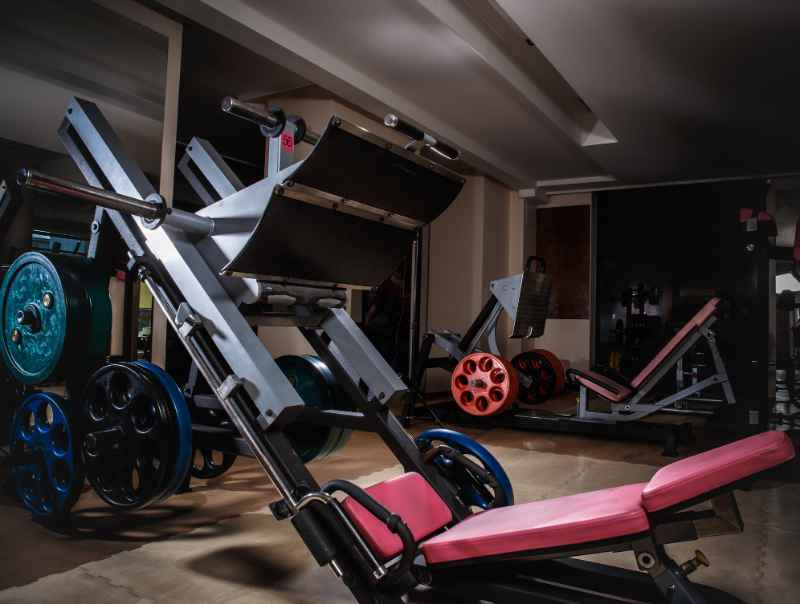
While the leg press primarily works the four muscles in the quadriceps, there are ways to train the glutes on the leg press machine by placing your feet “high and wide.”
The leg press machine is a great choice for general hypertrophy, for those who have weaker knee stabilizers (the VMO in particular, the teardrop-shaped quad muscle right beside your knee), and offers a lot of flexibility in terms of muscles targeted.
See also: 6 Best Smith Machine Leg Exercises (Plus a Sample Leg Workout)
Additionally, the leg press machine can be used as a modified calf raise machine (use the bottom of the footplate for maximum ankle dorsiflexion), making it a one-stop shop for almost all of your leg muscles.
In terms of lower body muscle and strength, safety, and versatility, the leg press is my top–and many other lifters, too!–choice for leg machines.
2. Hack Squat Machine
The hack squat machine looks a lot like a leg press, and in reality, that’s because they often are!
Essentially, doing a hack squat means you flip around and push down instead of up (this is why many home-based leg press machines also have the ability to turn into hack squat machines).
Your local gym is more likely to have a dedicated hack squat machine (which you can also do reverse hack squats on). They are angled in a similar way to the leg press machine, usually at a 45-degree angle.
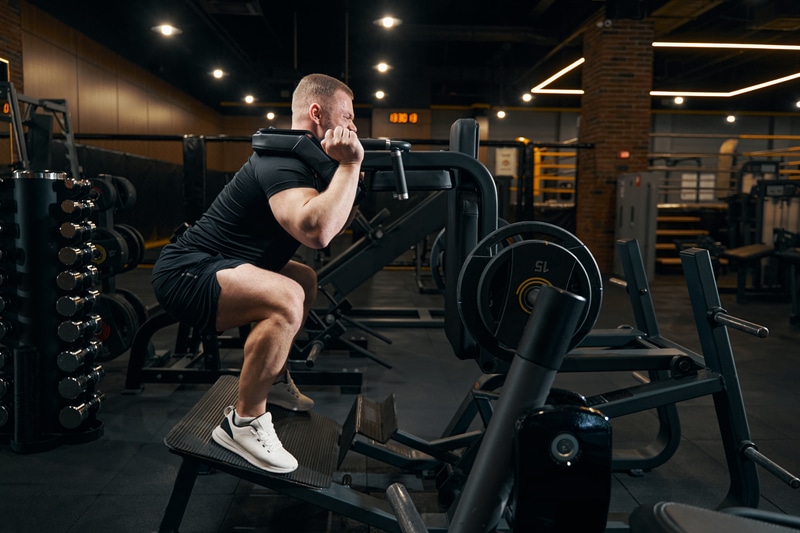
The exercise is a great balance between free weight squats and the leg press, making it an excellent tool for improving your regular squat while targeting the quadriceps like a boss.
Hack squats are easier on the shoulders and back (especially lifters who don’t can’t externally rotate their shoulders to properly grip the barbell when doing back squats) while still providing the controlled resistance of a machine.
And like the leg press machine, you can safely experiment with hack squat foot positions for targeting different muscle groups.
More Hack Squat Resources:
3. Leg Extension Machine
The leg extension machine is a classic leg development tool found in local gyms.
The super short learning curve makes it an essential exercise for people new to strength training.
Park your butt in the seat, tuck your leg under the roller, adjust the weight, and raise the weight. Pretty tough to mess that up!
Another key benefit of the leg extension includes being able to train unilaterally, meaning you can exercise one side at a time.
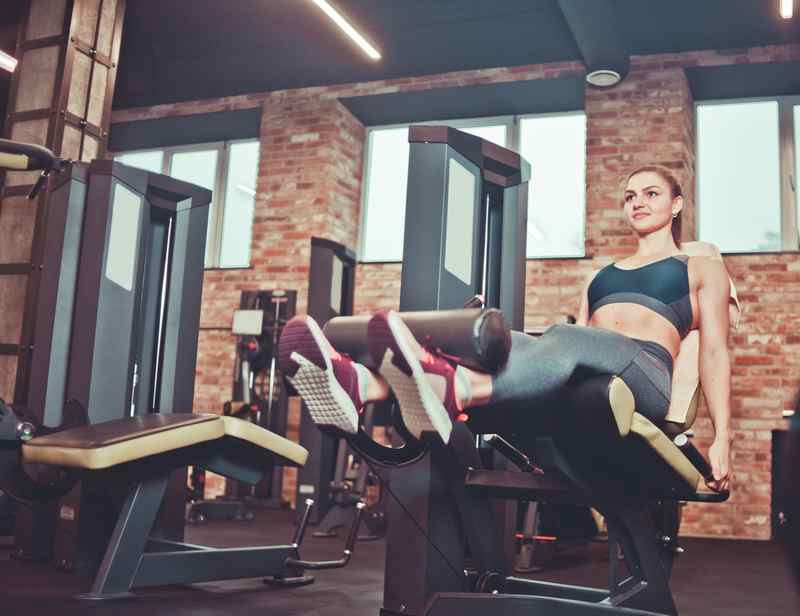
This is great for addressing muscle imbalances and keeping you honest about training both sides of your body with equal vigor.
Leg extensions really target the quadriceps, allow you to build better muscle awareness, and they are also a great choice for “finishers” (when you rep out to total failure) as there is no risk of the weight being dropped in an unsafe manner.
4. Leg Curl Machine
Okay, so far all of the leg machines we have covered are geared at targeting the quads.
The leg curl machine mixes things up, being a predominantly hamstring exercise, working the three big muscles in this group, including the biceps femoris, semitendinosus, and semimembranosus (don’t worry—there won’t be a test later).
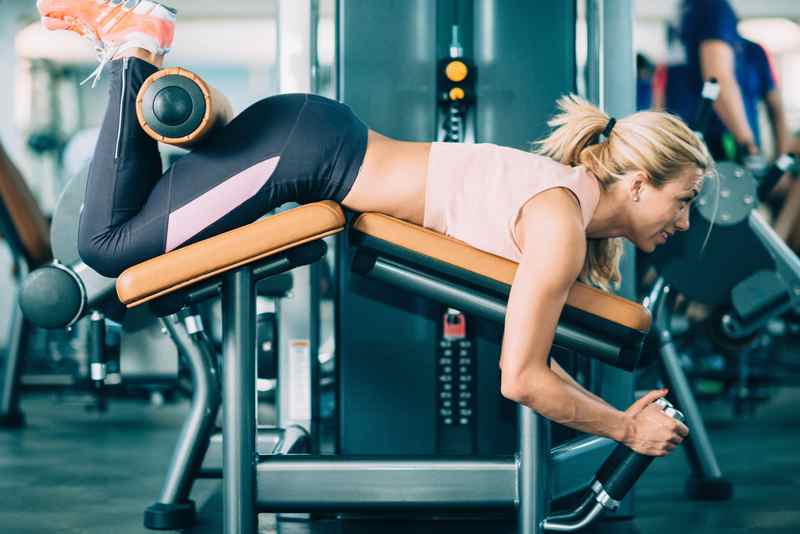
While this exercise targets the big cables on the back of your legs, other recruited muscles include the calves and glutes.
Having strong hammies is crucial, especially for speed and power-based activities like running and jumping1, and can also help you develop bulletproof knees.
The leg curl machine is a good starter exercise, but there are some better ways to target your glutes (hip thrusts, for example).
5. Hip abduction/adduction machine
This machine is definitely one of the more awkward leg machines in the gym.
You sit in, spread your legs, either pushing resistance out or pushing it inwards, targeting the abductors and adductors, stabilizer muscles that help you move properly, whether that’s walking or standing.
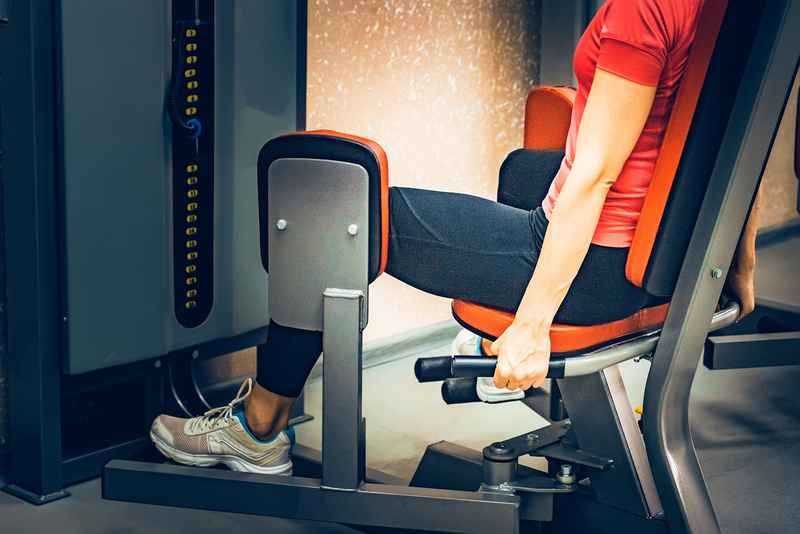
Because they are stabilizer muscles, they aren’t really supposed to be worked in isolation this way.
While the machine certainly will make the adductors and abductors stronger, when not strengthened in conjunction with the glutes and quads, the utility of the exercise disappears quickly.
The hip abductor is one of the most commonly injured muscles2 in people who play sports, so it’s important to train it without excessively fatiguing it and creating muscle imbalances that will further increase the likelihood of injury.
While there may be some instances where using this machine is preferred—limited mobility, for example—you are better off using a resistance band for targeting the abductors and adductors.
Exercises like monster walks, banded squats, and standing hip abductors/adductors are way more functional forms of training these muscles.
See also: 6 Best Fabric Resistance Bands for Big Booty Gains
6. Calf Raise Machine
Calf raises, whether done on a standing calf raise machine or a seated machine, are an excellent way to improve ankle stability, isolate the calves for muscle and strength development, and at lighter loads and full range of motion, significantly improve ankle flexibility and mobility.
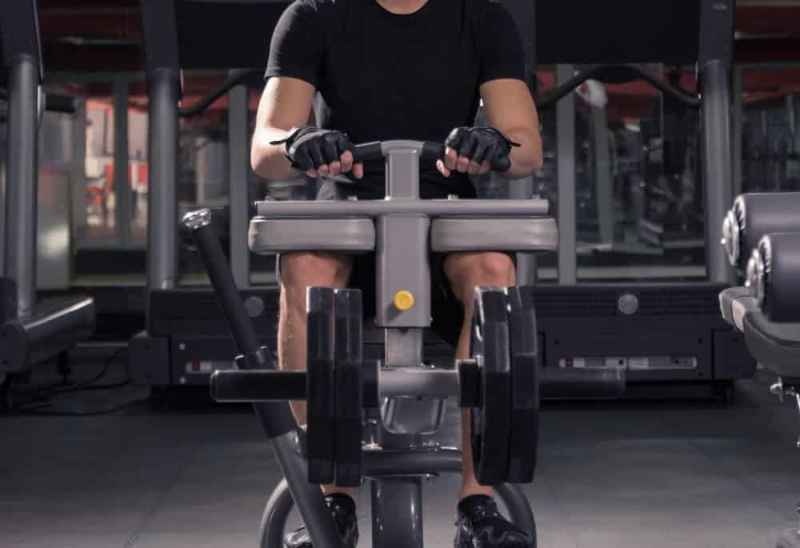
The calf raise machine can be used to train unilaterally for greater muscle recruitment, and calf raises are one of my favorite exercises to cap off a successful leg day workout once the big muscle groups have been sufficiently worked.
Additionally, because you are using a machine to target the calves, you can do higher volume sets and reps as the CNS demand is significantly less than free weight exercises.
7. Smith Machine
While not specifically a leg machine, the Smith Machine is one of the most popular tools for doing lower body exercises like Smith Machine squats, lunges, deadlifts, and even hip thrusts.
The Smith Machine takes a regular squat rack and adds a fixed barbell that slides up and down using a carriage system. Because the barbell is fixed, you don’t have to worry about losing balance or having the barbell slide off your back.
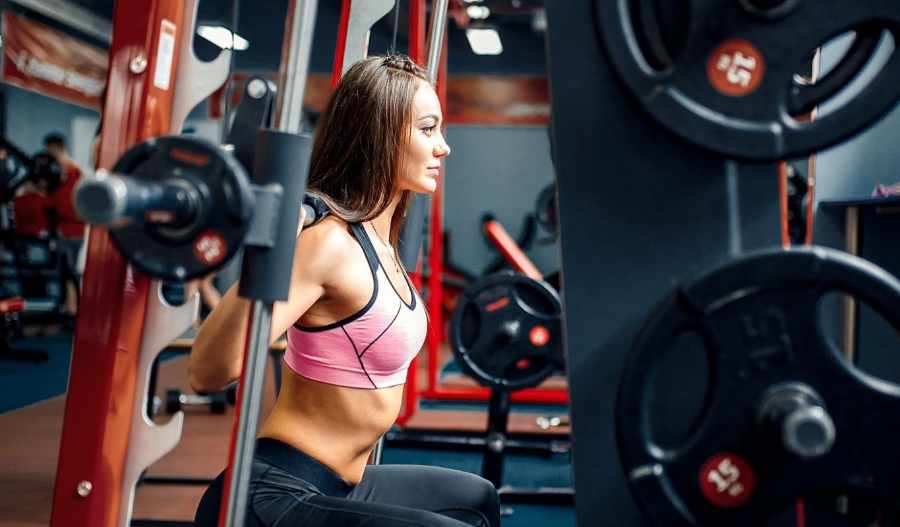
The path of the bar is either vertical or pitched at a 5-7-degree angle to better mimic the natural arc of a weight being lifted up.
While the Smith Machine gets hate from purists and old-school snobs, the machine gets plenty of love (including from 7-time Mr. Olympia Arnold Schwarzenegger, who still uses his to this day) for its versatility.
While not a dedicated leg machine, it can be used for a huge variety of unilateral and bilateral leg exercises, including lunges, squats, presses, standing calf raises, and much more.
More Smith Machine Guides:
The Bottom Line
As you can see, there are a ton of options for training and strengthening the lower body and your legs when you hit the gym!
Fortunately, many of the same machines target the same muscles, so you now know that you have some flexibility in machine choice the next time you step into your local gym.
Pick your leg machines of choice, bang out those reps, and get after those gains!
More Guides and Articles Like This
⭐ 7 Best Smith Machines for Home Gyms. Skip the lineups at the gym (and the commute!) with a detailed look at the best Smith Machines for home gyms, including key features, a buyer’s guide, and more.
How to Do Squats Without a Squat Rack. No squat rack? No worries. Here are some effective barbell squat alternatives that you can do to conquer leg day.
6 Benefits of Dumbbell Squats (Plus Disadvantages and Variations). Wondering if the dumbbell squat is a good way to train your legs? Here’s a detailed look at the benefits of dumbbell squats and how it’s superior to other squat alternatives.